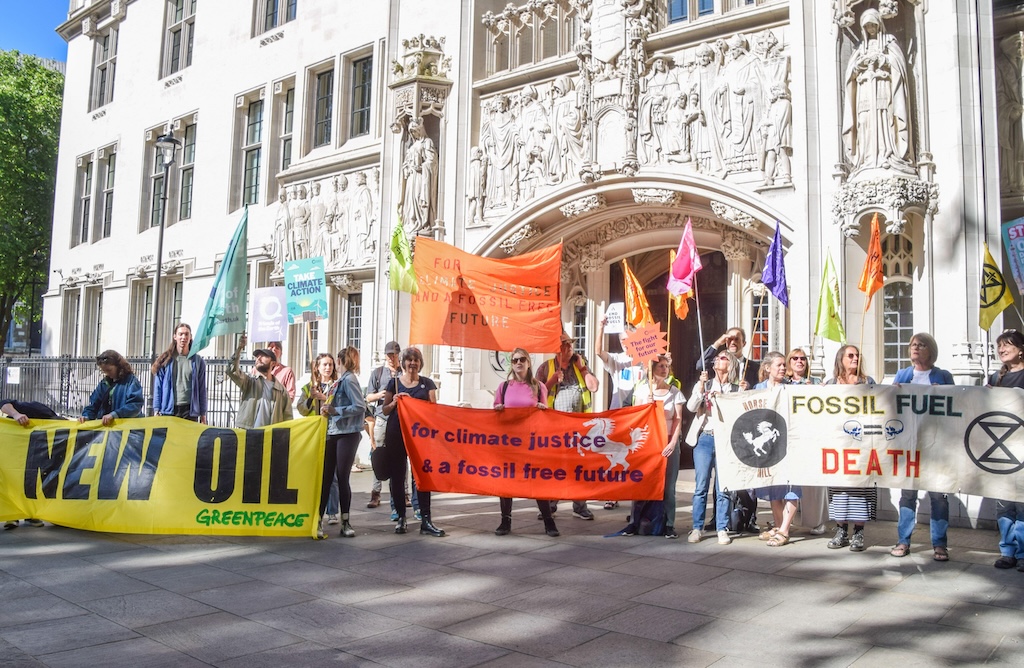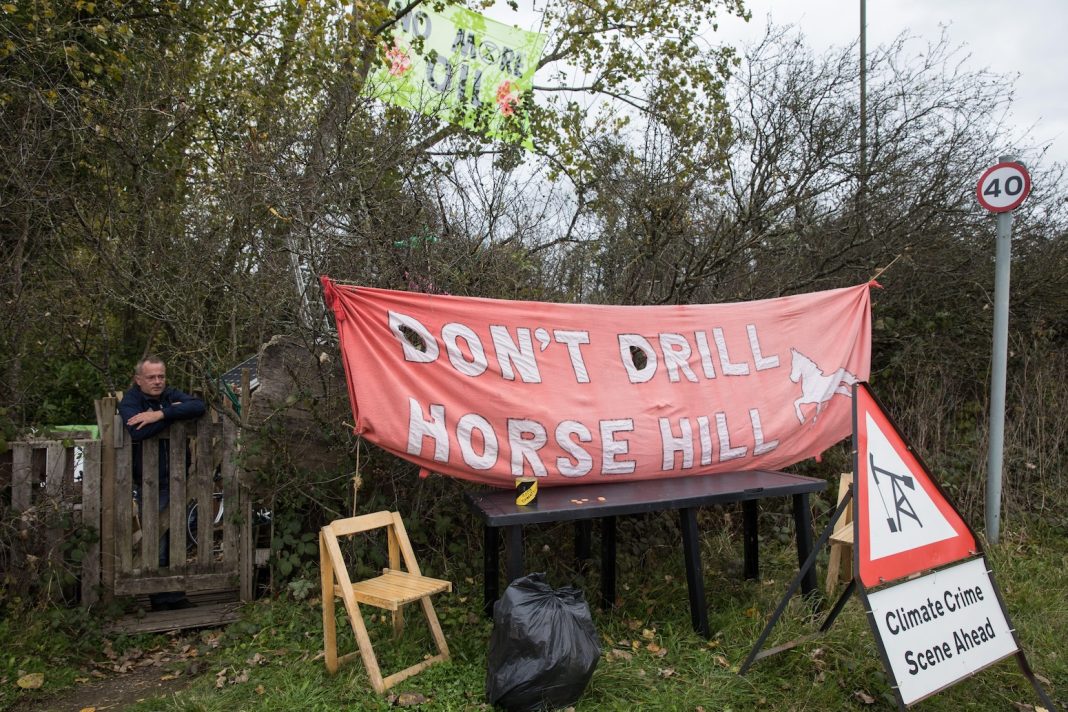Earlier this month, a years-long legal attempt by community and environmental groups to challenge a new oil project in Horse Hill, Surrey resulted in victory – with implications for all new fossil fuel projects in the UK.
On 20 June, the Supreme Court, the highest court for civil cases in the UK, issued a majority judgment ruling that Surrey County Council acted unlawfully by granting planning permission for the project, because councillors did not consider the climate impact from burning the fuel.
It came after an “incredibly finely balanced” legal battle, which saw multiple courts reject the arguments made by environmental groups – and judges in the Supreme Court take nearly a year to come to their own conclusion.
The judgment, which will now lead to changes in how the environmental impact of new fossil fuel projects is assessed, has been described as “landmark”, “watershed” and “tide-turning” by environmental groups, while right-leaning media warned it could “kill off the oil industry” completely.
Below, Carbon Brief speaks to environmental lawyers to unpack what happened in the Horse Hill case, what it actually means for UK fossil fuel production and how it could affect the policies of the next UK government.
What happened in the Horse Hill case?
The story began back in 2012 when Surrey County Council granted planning permission for Horse Hill Developments Ltd to dig an exploratory oil well at Horse Hill, a site close to the town of Horley in Surrey and 3.5km north of Gatwick Airport.
In 2017, the council granted permission for a second borehole, a sidetrack well and for testing to commence.
In 2019, the council granted permission for the project to start drilling for oil – just two months after it had passed a motion declaring a climate emergency. The project was to include six oil wells, which would produce 3m tonnes of oil over a 20-year period.
In 2020, Sarah Finch, a freelance editor representing the Weald Action Group, a network of organisations opposing oil and gas in southern England, decided to challenge the council’s decision to grant planning permission in the High Court, with charity Friends of the Earth acting as the legal intervener.
(There is a clear scientific consensus that new fossil fuel projects are incompatible with meeting the Paris Agreement’s ambition of keeping global temperatures at 1.5C.)
Finch and her representatives argued that the decision to permit the oil development was unlawful because the council did not take into account the climate impact of burning the fossil fuels produced by the project.
Under an EU directive that has been incorporated into UK law, any development that is likely to have a significant effect on the environment must carry out an environmental impact assessment (EIA). This assessment must be considered by the decision makers responsible for permitting the project.
The legal challenge argued that the EIA for the Horse Hill drilling project only considered the climate impact from the process of dredging up the oil from the ground, rather than from burning the oil.
As with any fossil fuel project, the emissions from burning the fuel are far larger than those from simply setting up operations, Katie de Kauwe, the lead in-house lawyer at Friends of the Earth, explains to Carbon Brief:
“In the Finch case, the developer assessed that the operational emissions were around 114,000 tonnes of [carbon dioxide] equivalent (CO2e). But then during the hearing, it was recorded that the end use emissions from burning the oil were over 10m tonnes. So they really are dwarfed. And the decision maker had no information on that whatsoever when they granted permission for the oil drilling in Surrey.”
But, in December 2020, the High Court ruled that the council had acted lawfully, with the judge concluding that it would have been “impossible” for the council to have considered the emissions from burning the oil.
Finch appealed the decision. In November 2021, a Court of Appeal hearing before three judges resulted in an “unusual” split decision, with two judges upholding that the council acted lawfully and the third producing a strong dissenting judgment that it had not.
In contrast to the High Court judgment, the Court of Appeal judgment said that decision makers for fossil fuel projects are not prohibited from considering the emissions from burning the fuels.
However, in practical terms, it left it up to the decision makers themselves as to whether they will consider these emissions or not.
Finch appealed again, leading to a hearing before the Supreme Court, the highest court in the UK for civil cases, in June 2023. This took place before five judges.
In this hearing, legal interventions were made by Friends of the Earth, Greenpeace, the Office for Environmental Protection and representatives of the company behind a new coal mine in Whitehaven, Cumbria, which itself is facing a legal challenge from environmental groups (more on this below).
The Office for Environment Protection was set up post-Brexit to act as an independent environmental watchdog, pursuing the enforcement of environmental law and the introduction of new protections. It was the first time this office had intervened in a court case.

The Supreme Court took almost a year to deliver its judgment, which finally came on 20 June 2024.
It delivered a majority decision from three of the five judges that Surrey County Council had acted unlawfully in permitting the oil project, with the other judges giving a dissenting judgment.
Delivering the majority judgment, Lord Leggatt ruled that the decision to grant planning permission for the oil project was unlawful as the project’s EIA failed to assess the climate impact of burning the oil, and the reasons for disregarding this were “demonstrably flawed”.
Rejecting the arguments made by the council, the developer and the government that the emissions from burning the oil were not within their control, Lord Leggatt said:
“The combustion emissions are manifestly not outwith the control of the site operators. They are entirely within their control. If no oil is extracted, no combustion emissions will occur. Conversely, any extraction of oil by the site operators will in due course result in greenhouse gas emissions upon its inevitable combustion.”
The Supreme Court said any suggestion that local planning authorities are unable to consider climate change when making planning decisions is “misguided”.
It also rejected the Court of the Appeal’s ruling that it should be up to the decision maker to decide whether to consider emissions from burning the fuels produced by new fossil-fuel projects, with Lord Leggatt saying this “would be a recipe for unpredictable, inconsistent and arbitrary decision-making”.
It is the first time in UK legislative history that a judgment has ruled that decision-makers should consider the emissions from burning fossil fuels – also known as scope 3 emissions – and not just those from the project’s operations.
It follows on from a similar ruling in Norway in January of this year.
In a statement, environmental charity ClientEarth lawyer Sophie Marjanac said the two judgments indicated that the world is “reaching a tipping point where countries and companies are going to have to comprehensively account for the impact of every fossil fuel project on the climate”.
Speaking to Carbon Brief, Angus Walker, an infrastructure planning solicitor, noted that, from the very start, the Finch case proved highly divisive among the court judges:
“It was incredibly finely balanced all the way from the very first stage…It’s interesting that the dissenting judgment is as long as the leading judgment, that also shows how finely balanced it was. And it took them a year to produce it, which I think is unusually long even for the Supreme Court. Does that mean they were agonising over it? I don’t know.”
Back to top
What does the judgment mean for other fossil fuel projects in the UK?
Much of the coverage of the judgment focused on what it could mean for the UK’s fossil-fuel industry.
Environmental groups described the ruling as “landmark”, “watershed” and “tide-turning”, while right-wing media warned it could “kill off the oil industry” completely.

Lawyers explain to Carbon Brief that the judgment will have consequences for new fossil fuel projects in the UK. However, it does not amount to a “ban” or “block” on Horse Hill or other similar projects.
Rather, the judgment makes it clear that, when an EIA is produced for a new fossil-fuel project, this should include information on the emissions associated with burning the coal, oil or gas produced – and not just the much smaller emissions from the project’s operations. Walker explains:
“It’s just assessing and reporting. The decision makers can still grant [an oil project planning permission], but it’s just about knowing what the impacts are. The judgment is careful to point out this is only information for the decision maker, it is not a factor that itself bans these projects from going ahead.”
Tessa Khan, an environmental lawyer and founder of Uplift, a group supporting actions on ending new oil and gas production, adds:
“It’s groundbreaking because, until now, when an EIA was done for an oil and gas project, you didn’t even need to know what the scope 3 emissions would be before you said that the environmental impacts were compatible with the decision to approve the project.
“What Horse Hill does is say that information has to be on the desk of the decision maker. But that doesn’t mean that that’s an automatic block on the project, it’s just one factor in the mix of different factors.”
The kinds of developments that are required to produce EIAs when looking to obtain development consent in the UK include onshore oil and gas, offshore oil and gas in the North Sea and coal mining projects.
When it comes to North Sea oil and gas projects, developers must first obtain a licence for fossil fuel exploration from the regulator, the North Sea Transition Authority (NSTA).
After this, developers will apply for development consent, which is granted by the NSTA and the secretary of state for energy infrastructure, which would currently be the secretary of state for energy security and net-zero, Claire Coutinho.
It is at this stage that project developers will have to produce an EIA containing information on emissions from burning the fossil fuels.
That means that oil and gas projects that have been awarded a licence for exploration, but have not yet obtained development consent, will be affected by the Horse Hill judgment.
Previous Carbon Brief analysis shows there are dozens of such projects looking to obtain development consent sometime between now and 2025.
North Sea oil and gas projects that have already received development consent, such as the Rosebank oil field, will not be automatically affected.
However, the judgment will offer new arms to legal challenges against such projects.
Khan, who is contributing to a legal challenge against Rosebank that is due to be held in the next few months, says:
“Our legal challenge against Rosebank, if we succeed, would mean that the decision has to be remade around the development consent. And so in making that decision, the government and the regulator would then have to consider the scope 3 emissions.”
Rosebank contains around 325m barrels of oil equivalent. Previous Carbon Brief analysis found that, when burnt, this would produce around 150m tonnes of CO2e – roughly the same as produced each year by 90 of the world’s lowest-emitting countries.
Coal mining is another activity that is likely to be affected by the judgment.
This likely explains why representatives from the company behind a new coal mine in Whitehaven, Cumbria, were moved to intervene in the Supreme Court case on Horse Hill, experts tell Carbon Brief.
The controversial project was permitted by communities secretary Michael Gove in 2022 and would be the UK’s first new deep coal mine in 30 years.
It plans to produce coking coal to be exported for global steel production, rather than for power production.
De Kauwe, who with Friends of the Earth is mounting a legal challenge against the coal mine to be held in the High Court on 16-18 July, said the reasoning used in the Horse Hill judgment is likely to hold true for the mining project:
“Coal’s role in all of this is to be burned as part of that steelmaking process. So it doesn’t matter that it’s not being used in power generation, it’s still the burning of fossil fuel.”
As with Rosebank, an overturning of the development consent given to the Cumbria mine by Gove would lead to the project having to produce a new EIA including information on emissions from burning the coal produced.
Back to top
Could it affect other carbon-intensive projects, such as airport and road expansion?
While it is clear that the judgment will have implications for fossil fuel projects in the UK, it is unlikely to have consequences for other carbon-intensive infrastructure projects, such as airport and road expansion, experts tell Carbon Brief.
The judgment makes it clear that the ruling only applies to fossil-fuel projects, de Kauwe says:
“I think Lord Leggatt is very clear that in requiring the assessment of downstream emissions for fossil fuel projects, this is not opening up the floodgates, that was something that had clearly bothered both the High Court judge and the Court of Appeal.”
The judgment specifically says that fossil fuel projects are unique when compared to other types of carbon-intensive infrastructure, such as aeroplane manufacturing, she adds:
“[Lord Leggatt] said that the difference with fossil fuels, these have an inevitable use. They’ve only got one use. It’s for combustion.”
Walker adds that both road and airport expansion projects already consider the additional emissions from creating more car traffic or flights.
Back to top
What could the judgment mean for the next UK government?
The judgment comes just days before a general election in the UK.
Carbon Brief has assessed where each party stands on fossil fuels. For example, the Conservatives have pledged to continue issuing new North Sea oil and gas licences, while Reform has promised to “fast-track” them.
Polls suggest that the Labour party is likely to win the election.
Labour’s manifesto says it “will not issue new licences” for oil and gas exploration, but that it “will not revoke existing licences”, leaving vagueness around whether it will grant development consent to new projects that have an exploration licence already.
Outside of the manifesto, representatives of Labour have previously pledged to put a stop to Rosebank and Cambo, two of the largest new oil and gas projects.
In light of the judgment, it is probable that the new energy secretary, which is likely to be the shadow energy and net-zero secretary Ed Miliband, will be faced with deciding whether to grant development consent to new North Sea oil and gas projects – with, for the first time, full knowledge of the emissions that will be caused by burning the fuels produced.
Commenting on the likely impact of the judgment on decision makers, Walker says:
“It makes the negatives appear greater, I would have thought, when weighing up whether to give consent.”
Back to top


